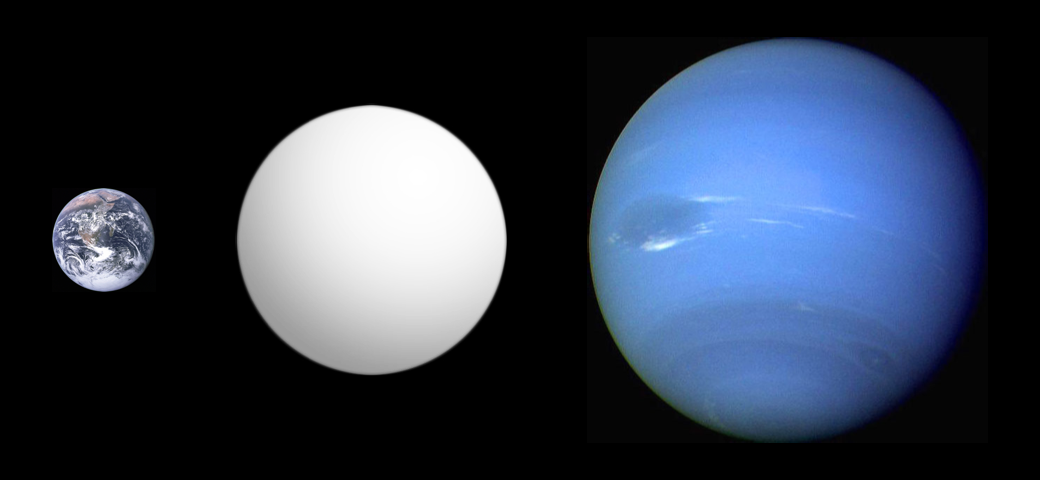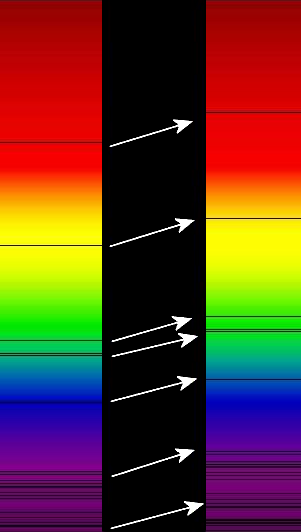Artist's impression of GJ 1214 b passing its star, by ESO/L. Calçada.
These astronomers were working on the MEarth Project, looking at thousands of red dwarf stars, named for their color and size. (Yes, astronomers call a star many times larger than Jupiter a "dwarf." You should see what they call "giants.") GJ 1214 is one of these red dwarfs, and its only known planet earned the name GJ 1214 b (the star itself would be considered GJ 1214 a, if you were wondering).
By 2009, planet-hunting had become a science (ha ha). Get a powerful telescope (the more, the merrier), aim at a patch of sky, feed the data into a computer program, and wait. The computer will scan the images, looking for changes in brightness in all the stars in view. When a planet gets in between its star and us, it blocks some of the light, and the stars brightness dips. Since a planet has a regular orbit, it will cause these dips on a regular schedule. Anyone out in space looking at our star from the right angle will see it dip a bit once every year as we pass by. They'd see a much bigger dip every 12 years as Jupiter passes by, since it blocks much more light.
But even though we're getting the process down, the number of planets we know of is still only about 760, much fewer than the 160 billion we estimate are out there orbiting other stars, not to mention the trillions we think are free-floating throughout the galaxy.
Cartoonish view of planets in the galaxy, by ESO/M. Kornmesser.
With only 760 confirmations (so far), we can take a closer look at each, and really try to find out as much as possible about them.
But what can we learn from a dip of starlight? You might be surprised.
Orbit
First, the time in between dips tells us how fast the planet is moving around its sun. A dip every day and a half tells out that star has a planet moving around every day and a half. In other words, that planet has a year that is only 1.5 Earth days long! The shortest year in the solar system belongs to Mercury, at about every 88 (Earth) days, and the planet's years get longer the further out you go. Neptune has only completed one full orbit since it was discovered in 1846!
Size
It was also relatively easy to find the size, mass, and therefore density, of GJ 1214 b from one dip in starlight. A large planet would block more light than a small planet, so by measuring how much the light dims, the size of the planet can be known, and it turns out that about 20 Earths could fit in the same space, putting it between the sizes of Earth and Neptune.
Relatives sizes of Earth, GJ 1214 b, and Neptune by wikipedia user Aldaron.
Mass
Finding the planet's mass requires taking apart the light from its sun that reaches us. Isaac Newton, apart from discovering the laws of gravity and inventing calculus, famously proved that sunlight (which is white light, not yellow) can be split by a prism into every color of the rainbow. In fact, the reason we think of the rainbow has having specifically 7 colors is because those were the colors Newton identified.
This technique was refined by Joseph von Fraunhofer, who also discovered (though he wasn't the first) that the rainbow of sunlight is not an unbroken spectrum, but has dark bands. These are known as Fraunhofer lines, and they are a chemical signature of what elements were in the path of a beam of light. A beam of photons, uninterrupted, will produce a complete rainbow. But if some hydrogen gets in the way, it blocks the photons producing a specific wavelength of red light, so a Fraunhofer line shows up there, and we know that some hydrogen is out in the direction of the light source. Since all red dwarf stars fuse hydrogen into helium, they all give off light with Fraunhofer lines where hydrogen and helium block the photons, in the red and blue-indigo areas, respectively.
What does all this have to do with the planet's mass? I'm getting to that, I promise!
Now, as a star moves toward us and away from us, the light waves it gives off stretch and condense. When it moves away from us, the waves stretch and the colors shift toward the red end of the spectrum. This is called a redshift. (Scientists are not the most imaginative with names.) When the star moves toward us, the waves condense, and the colors move toward the blue. Yes, this is called a blue shift. We know how much the light has shifted by looking for the signature hydrogen and helium Fraunhofer lines. They'll end up shifted toward the red (the star is moving toward us) or the blue (away from us).
We can find how much mass stars have based on their luminosity, or how much light they give off, as well as closer observations of nearby stars. Stars are predictable beasts, and their color and brightness can tell us so much because they all fit a pattern. Red dwarf stars are part of the "Main Sequence" class of stars, and so is our sun. All stars in the Main Sequence with the same color and luminosity will invariably have the same mass.
From there, it's a relatively short leap to find the mass of the planet GJ 1214 b. As a planet moves around a star, the star pulls on the planet with great gravitational forces to keep it in orbit, but the planet pulls back, and its gravity pulls the star a little closer to it, making the star itself move in little circles*.
We can measure the stars motion using the change in redshift and blueshift of the light it gives off. The more massive the planet, the more the star moves, the greater the redshift/blueshift. So once we know the star's mass and the change in redshift and blueshift, we can use a calculation to find the planet's mass, which is about 6.5 times the mass of Earth.
Density
Remember the size of the planet is about 20 times the size of Earth, so if it were to have the same density, it should have about 20 times the mass as well. Having only 6.5 times the mass of Earth, that tells us GJ 1214 b is very light for its size, but it is still more dense than any of the gas giants in our solar system (Jupiter, Saturn, Uranus, and Neptune). It's somewhere in between.
Composition
Simply knowing the density (and the known laws of planet formation) narrows down what GJ 1214 b could be made of. It could be rock with a thick hydrogen atmosphere, a small gas giant (pardon the oxymoron) with a core made up more of liquids than solids, or a world made up almost entirely of liquid water. The only way to know for sure is through a little more spectrometry!
What we can now do is watch the star, record the spectrum of light in detail, and pinpoint all the Fraunhofer lines to come up with the exact chemical composition of the star alone. Then, when GJ 1214 b passes by, record the spectrum again. New Fraunhofer lines appear, some will fade, and some will strengthen. The new spectrum, compared to the old, should tell us what is in the atmosphere of GJ 1214 b.
And the answer is...? Well, actually, we aren't 100% sure. The results ruled out the rocky-world-with-hydrogen-atmosphere hypothesis, since no extra hydrogen was detected. In fact, the atmosphere appears to be so thick, it didn't let any light through to be picked up by our telescopes! A hydrogen-rich atmosphere would have let some through to get to us, so at this point, the most likely scenario is that GJ 1214 b is a rocky world, completely covered in liquid water, orbiting so close to its sun that the atmosphere is filled with boiling steam. But who knows what lies under that steam, in its vast oceans, at the bottom of its seas, close to the thermal vents that may be spewing superheated sulfurous water like the ones on Earth?
Links:
http://en.wikipedia.org/wiki/Exoplanets
http://en.wikipedia.org/wiki/GJ_1214_b
http://en.wikipedia.org/wiki/Fraunhofer_lines





oh my gosh- you just succeeded in interpreting so much info in such a light-handed, wonderful read! I love learning about all of this. Thank you very much, Robert.
ReplyDeleteVery cool, very clear. Thanks again!
ReplyDelete